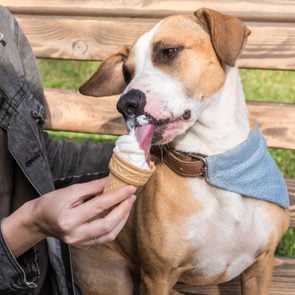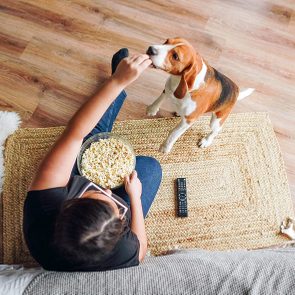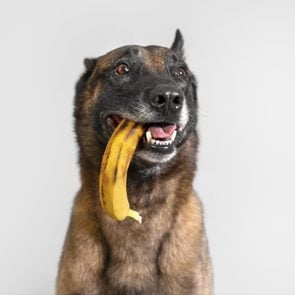These Are the Most Common Dangerous Items Dogs Get Into
Updated: Jan. 25, 2024
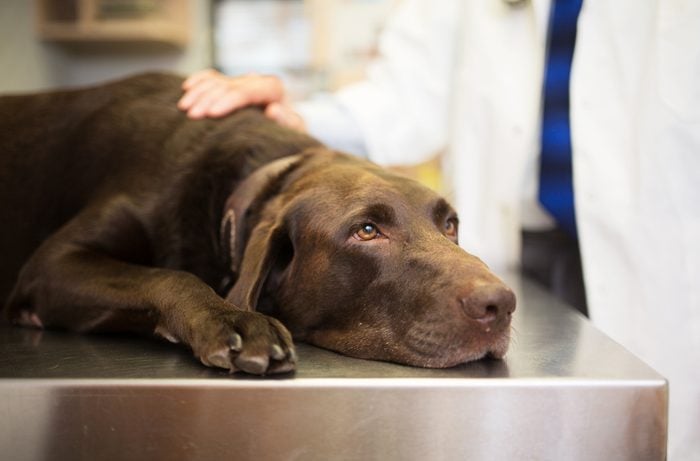
Dogs are famous for putting anything and everything into their mouths. But these items in your house could be hazardous to their health.
Let’s be honest: Dogs don’t have the most discriminating palettes. Sure, your pup will eat watermelon and gobble up eggs, both of which appeal to human tastes. But that same dog has also been known to savor the flavor of its own poop and vomit.
Because dogs will lick just about anything, the items in and around your home that aren’t safe for canine consumption are cause for concern. The last thing you want is for your four-legged friend to get sick on your watch. Luckily, if you know where the biggest risks hide, you can create a safer environment for your precious pal.
Not sure where to start? You’re in luck. In honor of National Dog Month, the expert question-and-answer website JustAnswer reviewed nearly 200,000 discussions between pet owners and JustAnswer veterinarians and pet experts. The sessions took place via online conversation between Jan. 1, 2022, and June 1, 2023. In the review, the team looked at the most popular answers to this question: “Help, my dog ate ___.”
These are the top nine answers, ranked by the total number of chats. (And no, “my homework” isn’t No. 1.)
Get Reader’s Digest’s Read Up newsletter for more pets, humor, cleaning, travel, tech and fun facts all week long.
9. Gum
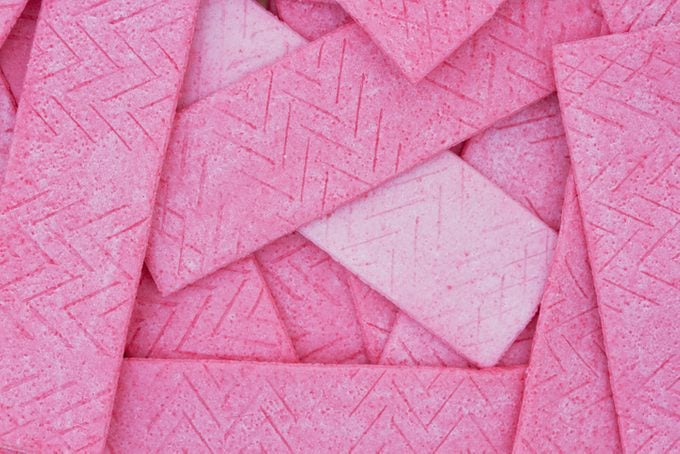
When your dog swallows gum, it’s worrisome for a couple of reasons. For starters, some types of gum contain the sugar substitute xylitol, which can cause liver damage and hypoglycemia, a health condition that occurs when blood glucose levels drop dangerously low. “If your dog’s hypoglycemia is left untreated, this can lead to seizures and even death,” says veterinarian Charles D. McMillan, DVM, owner at GoodVets in Atlanta. “The damage caused to the liver is usually reversible over time with proper therapy.”
Gum that doesn’t contain xylitol can still wreak havoc on your dog’s health. It might not be toxic, but it can give your pup an upset tummy or intestinal blockage.
What to do if your dog eats gum: Get your dog to a veterinarian, stat. Hypoglycemic seizures may occur quickly following xylitol ingestion. Your veterinarian will initiate decontamination by inducing vomiting, begin symptomatic treatment and monitor your dog’s blood glucose and liver values.
8. Cookies
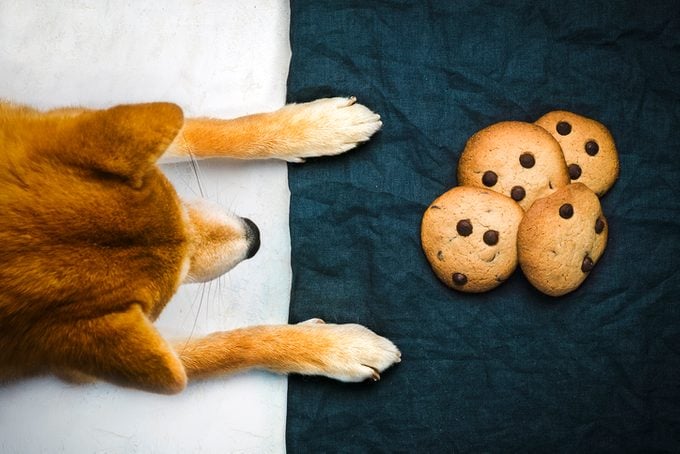
“Cookies can be especially dangerous when they contain certain types of sugar alcohols and chocolate,” says Dr. McMillan. Pay especially close attention to the sugar alcohol xylitol. Aside from gum, it’s often found in sugar-free foods, and it’s the only sugar substitute known to cause hypoglycemia (low blood sugar).
Chocolate contains methylxanthines, which dogs can’t metabolize the way humans can. They accumulate in the body, which may cause vomiting, diarrhea, increased thirst, hyperactivity or even more severe symptoms, such as seizures and irregular heart rhythms.
You’ll also want to keep cookies with raisins out of reach, as they are toxic to dogs too.
So what can you give your dog when he’s been a very good boy? Stick with dog treats or even whip up a dog-friendly cake instead.
What to do if your dog eats cookies: Call your veterinarian or pet poison hotline and share as many details as you know about how many cookies your dog ate, the ingredients in them and when the dog ate them. The ASPCA Poison Control number is 888-426-4435. A consultation fee may apply.
The first order of business when dogs eat xylitol and chocolate is to induce vomiting. Your vet might also use activated charcoal to bind the chocolate and keep it from being absorbed by the gastrointestinal tract. And if the cookies contained xylitol, the doc may monitor your pet’s blood glucose and liver values for a few days.
7. Chicken
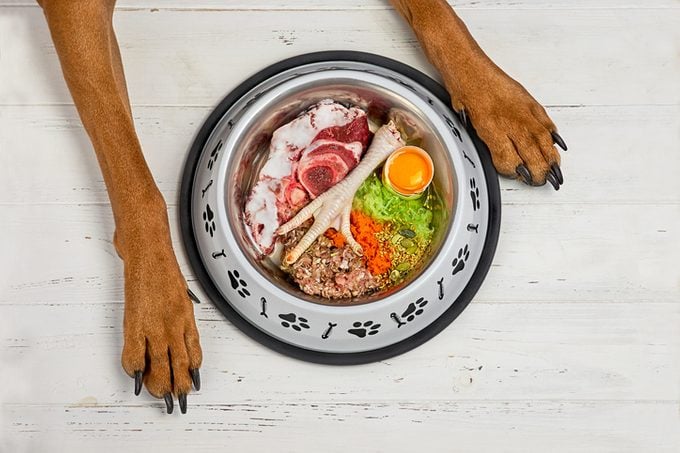
Chicken is actually one of the human foods dogs can eat. The danger lies in how it’s prepared. Raw or undercooked chicken (and any animal-sourced protein) may be contaminated with various pathogenic organisms, such as salmonella, Escherichia coli (aka E. coli) and Listeria, which can cause foodborne illnesses. And then there’s the issue of secondary transmission: Dogs can transmit foodborne pathogens to humans.
Cooked chicken with no sauce or seasoning may be OK under the guidance of your veterinarian. But it’s very risky to give your dog chicken bones. “Pet owners should refrain from feeding chicken with bones because ingestion of bones can cause upper and lower gastrointestinal disturbances or injuries and may become a choking hazard,” says Dr. McMillan.
What to do if your dog eats chicken: Some dogs may tolerate raw chicken, while other dogs show signs of sickness. If your dog is vomiting or has diarrhea, call your veterinarian. “It becomes a public safety issue if pet parents are consistently feeding raw or undercooked chicken due to pathogens being shed in the environment through the pet’s feces,” he says. “Some dogs that are chronically fed raw diets can also shed pathogens in their hair coat.”
6. Bottles
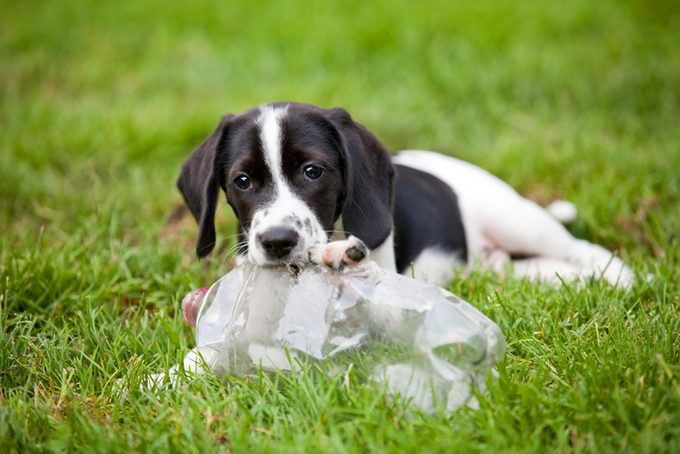
No, this isn’t about dogs eating bottles, although it wouldn’t be beyond the realm of weird dog behaviors for your pup to chew up a plastic bottle—especially since some dogs eat dirt and munch on grass.
Instead, panicked pet parents regularly exclaimed, “My dog ate a bottle of___!” What they’re trying to convey is that their dog ate a significant quantity of a specific drug.
“Any bottle of these drugs would be a huge risk, with the exception of some less-toxic issues. Vitamins, joint supplements, etc., could fall into less-concerning status, depending on the type and the amount,” says Grant Little, DVM, a veterinarian with JustAnswer.
What to do if your dog eats a whole bottle of something: Call the pet poison hotline or your veterinarian with all the information you can gather about the contents so they can advise you on the next steps for treating your dog.
5. Raisins
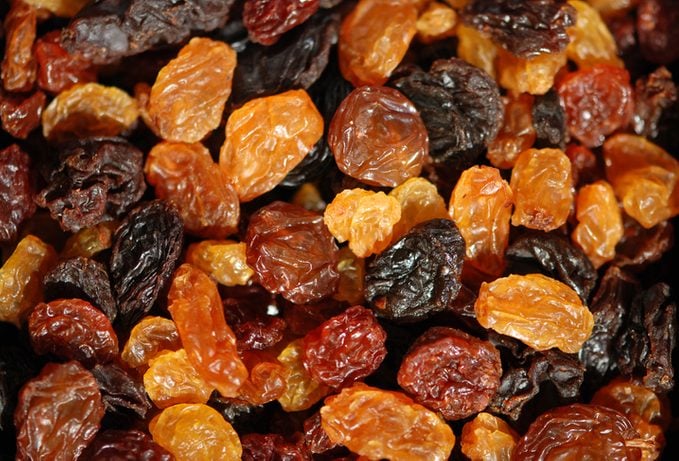
One thing veterinarians would never do? Give a dog raisins. Of course, that doesn’t mean your enterprising little pup won’t help itself. And whether your dog gets into those tiny boxes of raisins you toss into your kid’s lunch box or gobbles up an oatmeal raisin cookie, you may be looking at a trip to the vet. Raisins are toxic to dogs.
“Some dogs may develop symptoms after ingesting raisins (or grapes), while others may not,” says Dr. McMillan. Experts still don’t know why some dogs skate by with minor symptoms while others experience serious illness, but research suggests a possible connection between tartaric acid and its salt, potassium bitartrate, which are found in higher concentrations in grapes.
“Tartaric acid contents vary depending on the ripeness of certain fruits and could explain the inconsistencies of the development of signs following grape and raisin ingestion,” says Dr. McMillan.
What to do if your dog eats raisins: Take your dog to the veterinarian right away so the doctor can induce vomiting. Beyond that, your vet will provide supportive care and likely measure and monitor kidney values for several days. “The good news is the overwhelming majority of dogs that ingest grapes or raisins don’t develop any clinical signs,” says Dr. McMillan.
4. Grapes
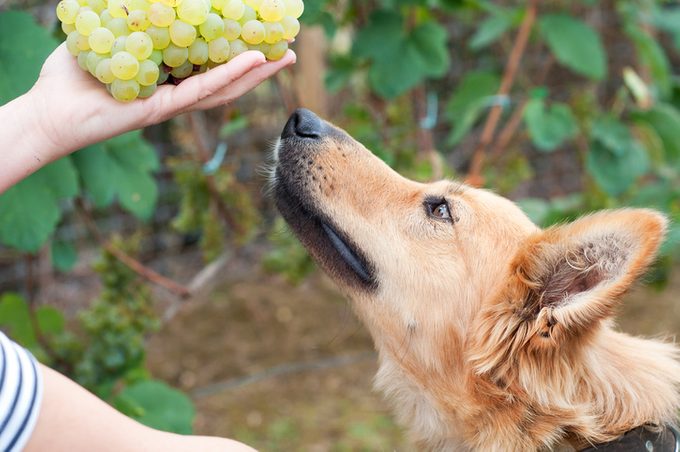
Dogs are more likely to eat grapes than raisins because people drop them on the floor or little kids pluck a few off to share with the dog, not knowing that certain fruits and veggies are toxic to dogs. Currently, veterinarians don’t have a toxic dose for the fruit. Various reports provide a range of potential toxic doses for a dog, from a single grape to dozens.
“Because of this vast range in dosing, it’s been determined that the process that causes this toxicity is an ‘idiosyncratic reaction,’ which is an unknown reaction that appears to be more associated with the individual pet as opposed to the dose itself,” says Dr. Little. In other words: You shouldn’t test how your dog handles grapes by feeding it “just a few.”
What to do if your dog eats grapes: Call your veterinarian or pet poison hotline as soon as possible. “Most dogs don’t seem to get toxicity from it, but the toxicity can cause severe acute kidney injury and be life-threatening,” says Dr. Little. Depending on the severity, treatment might include anything from decontamination therapy with induced vomiting to hospitalization with aggressive fluid therapy.
3. Medications
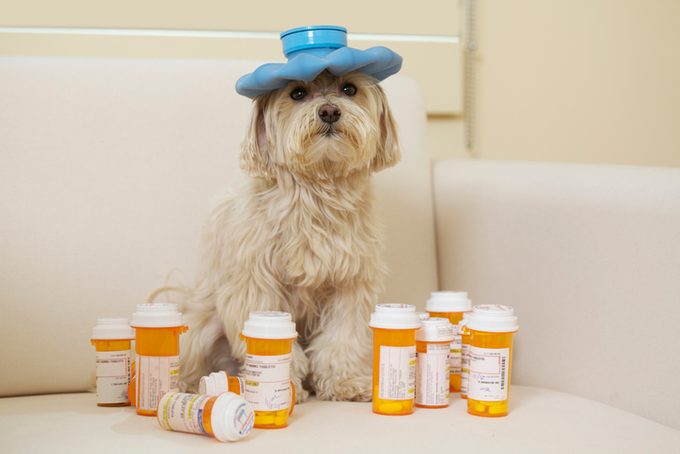
Oops! You spilled a few pills on the floor while trying to pry the lid off the bottle. And because your dog follows you everywhere, it’s quick to snatch one up and eat it. The scenario plays out more often than you might think.
“Any drug that would be commonly used in people to treat common diseases, especially chronic issues, is a common drug to be ingested by a pet,” says Dr. Little. Usually, the meds are the ones that people use daily, like nonsteroidal anti-inflammatory drugs such as Bayer, Motrin and Aleve; blood pressure medications; thyroid medications; and vitamins, especially vitamin D.
“These drugs have more noticeable toxic windows in pets because the dose is much stronger for them, or their ability to clear these medications is not as effective as in people,” says Dr. Little. For instance, medication meant to manage human hypothyroidism would provide an excessive amount of thyroid hormone for a dog.
As marijuana has become a popular alternative to traditional medication for treating diseases and illnesses (and now that it’s been legalized in more states for recreational and medicinal use), more and more pet parents are worrying about their furry friends accidentally eating marijuana and CBD gummies and edibles. In fact, questions on the topic have tripled since 2019, according to the JustAnswer report.
What to do if your dog eats your medicine: Whether your dog got into your stash of cannabis edibles (or canine CBD), baby aspirin or prescription cholesterol-lowering medicine, any small dose could be life-threatening. Call your veterinarian or pet poison control immediately and give them all the information you can about the medication. That includes the name, dosage, strength, how much your dog ingested and how long ago it ate the drugs. “This will help them determine the next appropriate step, and in some cases, the dose may not be an issue at all, depending on the amount ingested,” says Dr. Little.
2. Rat or other household poison
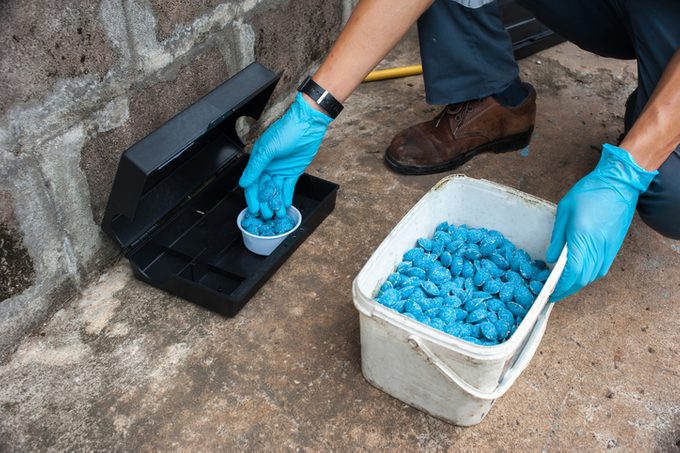
Dogs tend to be attracted to the things we find revolting (dog poop, remember?), so it’s plausible that they may find the scent of certain poisons tempting. At the very least, they may be curious about the container and ingest it. But considering the label contains the word poison, it’s probably no surprise this is a bad thing.
The toxicity from pesticides used to repel and kill insects and control plants or animals such as rats and mice can range from mild to life-threatening, depending on the substance and how much your doggo ate. “This is a broad classification that can include poisons that cause bleeding disorders, neurologic destruction of the brain, vitamin D toxicity leading to kidney disease and others as well,” says Dr. Little. “Pets can come in having seizures, they can be in complete kidney failure, or we can see pets bleeding into their chest or abdomen and completely in collapse.”
What to do if your dog eats rat or household poison: If possible, grab the label from the poison container so the poison control hotline or your veterinarian can analyze it. It’s also very helpful if you know how much your dog ingested to determine the level of toxicity. Early diagnosis and immediate medical care are essential and can save your dog’s life. Your veterinarian may be able to treat the illness with a decontamination process, but if your dog ingested a lot and the poison is particularly toxic, your sick pup may need to be hospitalized and treated with IVs and other medications.
1. Chocolate
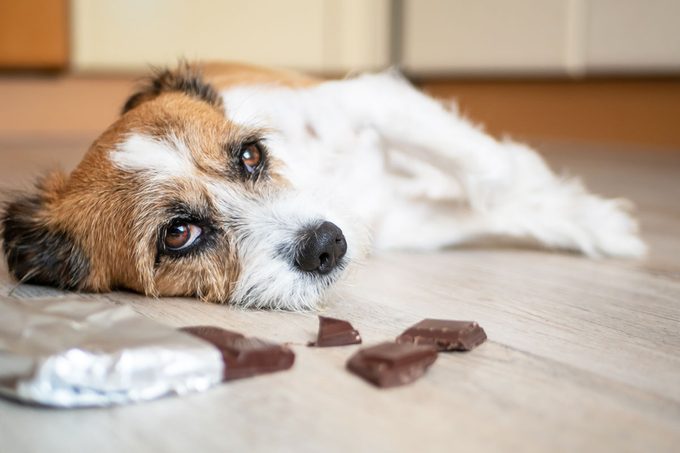
You would be hard-pressed to find an American household without even a little bit of chocolate hidden somewhere. But given dogs’ propensity for sweets—and getting into things they shouldn’t—there’s a good chance your four-legged companion is stealing your stash for itself. We get it: Chocolate is one of life’s greatest pleasures. But it’s also dangerous for dogs.
Chocolate contains compounds called methylxanthines, specifically theobromine and caffeine, which aren’t dog friendly. Your pup can’t metabolize them as effectively as you do. “Theobromine causes an overall stimulation of the central nervous system, leading to rapid and strong contractions of the heart, increased gastric secretions [vomiting and diarrhea], drinking and urinating, seizures and eventually death at a high enough dose,” says Dr. Little.
Its toxicity isn’t exclusive to dogs—it can be poisonous for all kinds of critters. Still, chocolate is one of the most common foods that are toxic for dogs, so it’s important to store yours out of your pet’s reach and pick up any spills right away.
What to do if your dog eats chocolate: Call your veterinarian or pet poison control immediately, as your dog will likely need to begin a decontamination process as soon as possible. Treatments vary depending on the size of your dog and how much chocolate it woofed down. Your vet may want to treat your pup at the clinic, but if the illness isn’t too severe, the doctor may give you options for treating your dog at home.
About the experts
- Charles D. McMillan, DVM, is a veterinarian and the medical director and owner of GoodVets in Atlanta.
- Grant Little, DVM, is a veterinarian with JustAnswer. He answers pet owners’ questions about their dogs and cats, along with other veterinary questions.
Source:
- ASPCA: “Animal Poison Control”

